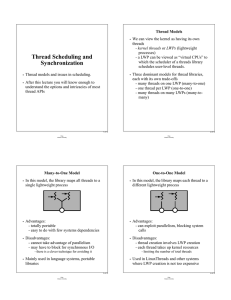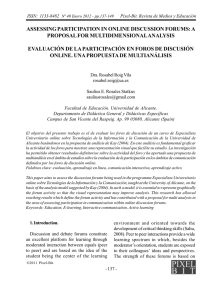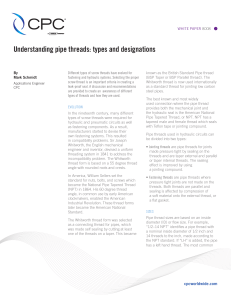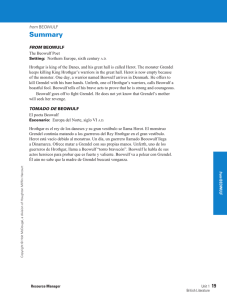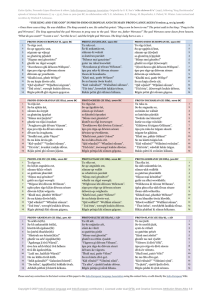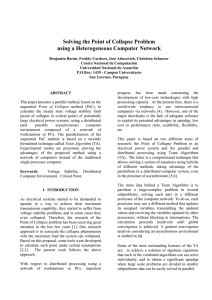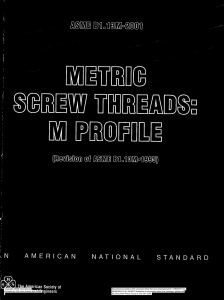ON ANY DESKTOP
Anuncio
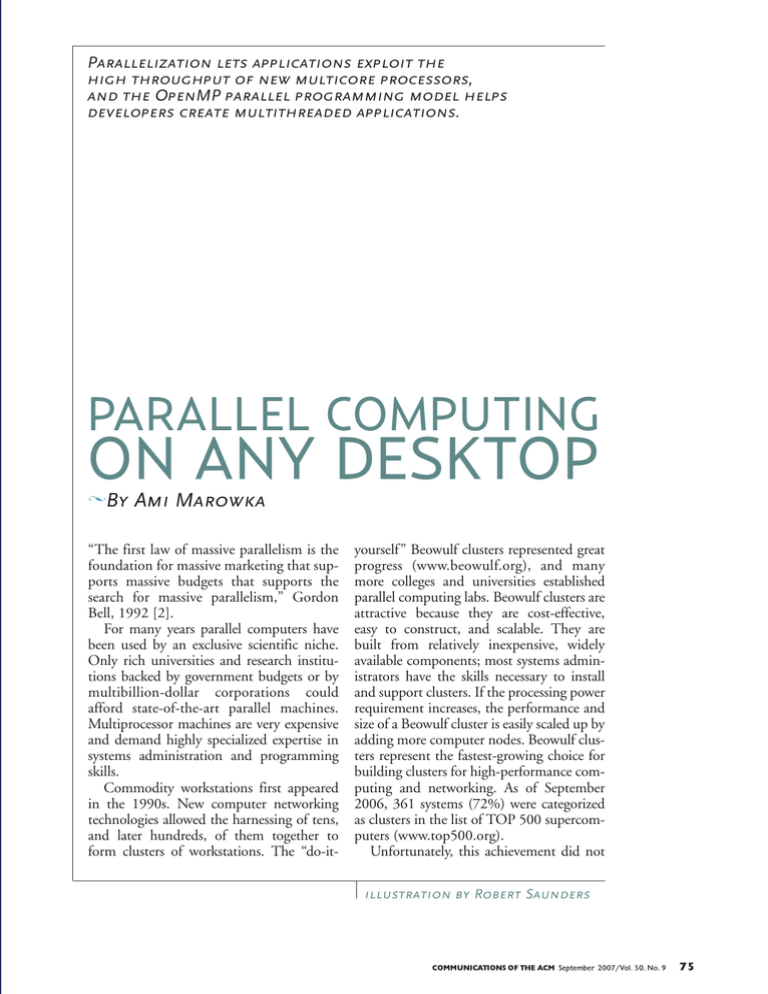
Parallelization lets applications exploit the
high throughput of new multicore processors,
and the OpenMP parallel programming model helps
developers create multithreaded applications.
PARALLEL COMPUTING
ON ANY DESKTOP
By Ami Marowka
l
“The first law of massive parallelism is the
foundation for massive marketing that supports massive budgets that supports the
search for massive parallelism,” Gordon
Bell, 1992 [2].
For many years parallel computers have
been used by an exclusive scientific niche.
Only rich universities and research institutions backed by government budgets or by
multibillion-dollar corporations could
afford state-of-the-art parallel machines.
Multiprocessor machines are very expensive
and demand highly specialized expertise in
systems administration and programming
skills.
Commodity workstations first appeared
in the 1990s. New computer networking
technologies allowed the harnessing of tens,
and later hundreds, of them together to
form clusters of workstations. The “do-it-
yourself” Beowulf clusters represented great
progress (www.beowulf.org), and many
more colleges and universities established
parallel computing labs. Beowulf clusters are
attractive because they are cost-effective,
easy to construct, and scalable. They are
built from relatively inexpensive, widely
available components; most systems administrators have the skills necessary to install
and support clusters. If the processing power
requirement increases, the performance and
size of a Beowulf cluster is easily scaled up by
adding more computer nodes. Beowulf clusters represent the fastest-growing choice for
building clusters for high-performance computing and networking. As of September
2006, 361 systems (72%) were categorized
as clusters in the list of TOP 500 supercomputers (www.top500.org).
Unfortunately, this achievement did not
illustration by Robert Saunders
COMMUNICATIONS OF THE ACM September 2007/Vol. 50, No. 9
75
increase the adoption of parallel
processors. A desktop computer
Start
computing. Beowulf clusters and
with a dual-core processor can
supercomputers assembled from Master thread
today be bought for less than
off-the-shelf commodity proces$500, a price affordable by stusors are still expensive, complidents and computer science
Parallel
region
cated to manage, difficult to
departments alike. Dual-core
program, and require specialized
processors are only the beginning
knowledge and skills. The batch Join
of the multicore-processor era.
processing involved preserves
Chip makers are working on the
mainframe methods rather than Fork
next generation of multicore
making them more interactive
Parallel processors that will contain four,
region
and user friendly.
eight, and 16 cores on a single die
The computing industry has
for both desktop computers and
been ready for the parallel comlaptops. The primary consequence
puting era for more than a decade.
is that applications will increasMost small-to-mid-size organizaingly need to be parallelized to
Stop
tions use multiprocessor servers;
fully exploit processor throughput
commercial databases (such as
gains now becoming available.
Figure 1. Fork-join
Oracle and Microsoft SQL
Unfortunately, writing parallel code is more commodel
servers) support parallelism; programming
of OpenMP. plex than writing serial code [8]. This is where the
Linux and Microsoft Windows
OpenMP programming model enters the parallel
Server System operating systems Marowka fig 1 (9/07)
computing
picture.
- 14 1/2
picasOpenMP helps developers create
are multithreaded; and programming languages (such multithreaded applications more easily while retainas Java) support multithreaded programming. How- ing the look and feel of serial programming.
ever, the massive breakthrough of parallel computing
many have been waiting for has still not occurred. OPENMP PROGRAMMING MODEL
Two things were missing until 2005: low-cost parallel Multithreaded programming breaks an application
computers and simple, easy-to-use parallel program- into subtasks, or “threads,” that run concurrently
ming environments. However, they are now available and independently. To take advantage of multicore
and will change the way developers design and build processors, applications must be redesigned for the
processor to be able to run them as multiple threads.
software applications.
OpenMP simplifies the complex task of code parTwo complementary technologies bring parallel
computing to the desktop. On the hardware side is allelization [6], allowing even beginners to move
the multicore processor for desktop computers; on gradually from serial programming styles to parallel
the software side is the integration of the OpenMP programming. OpenMP extends serial code by using
parallel programming model into Microsoft Visual compiler directives. A programmer familiar with a
C11 2005. These technologies promise massive language (such as C/C11) needs to learn only a
exposure to parallel computing that nobody can small set of directives. Adding them does not change
ignore; a technology shift is unavoidable.
the logical behavior of the serial code; it tells the compiler only which piece of code to parallelize and how
MULTICORE PROCESSORS
to do it; the compiler handles the entire multiDual-core processors first appeared on the market in threaded task.
2001 [3]. Chip makers Sun Microsystems and IBM
OpenMP uses the fork-join model of parallel exewere first; Sun introduced the Microprocessor Archi- cution (see Figure 1). An OpenMP program begins
tecture for Java Computing, and IBM introduced the with a single thread of execution, or “master thread,”
POWER4 dual-core processor. Like their predeces- which spawns teams of threads in response to
sors, these processors were expensive and optimized OpenMP directives that perform work in parallel.
for special-purpose computing-intensive tasks run- Parallelism is thus added incrementally, with the serning on high-end servers.
ial program evolving into a parallel program.
The greatest change in processor architecture came OpenMP directives are inserted at key locations in
with the dual-core processors that AMD and Intel the source code. These directives take the form of
introduced in 2005. Both were designed for desktop comments in Fortran or C/C11. The compiler
computers and caused a dramatic drop in the price of interprets the directives and creates the necessary code
desktop computers and laptops, as well as of multicore to parallelize the indicated regions. The parallel
76
September 2007/Vol. 50, No. 9 COMMUNICATIONS OF THE ACM
TO TAKE ADVANTAGE OF MULTICORE PROCESSORS, applications must be
redesigned for the processor to be able to run them as multiple threads.
region is the basic construct that creates a team of There is an implied barrier at the end of a parallel
threads and initiates parallel execution.
region; only the master thread of the team continues
Most OpenMP directives apply to structured execution at the end of a parallel region.
blocks, or blocks of code with one entry point at the
The for keyword identifies an iterative work-sharing
top and one exit point at the bottom. The number of construct that specifies the iterations of the associated
threads created when entering parallel regions is con- loop to be executed in parallel. The iterations of the for
trolled by an environment variable or by a function call loop are distributed across the threads in a round-robin
fashion according to the
from within the program.
order of the thread numIt is possible to vary the 1. #include <omp.h>
ber. The private(x) Start
clause
number of threads created 2. float num_subintervals = 10000; float subinterval;
declares the variable x to be
in subsequent parallel 3. #define NUM_THREADS 5
void main ()
private to each thread in
regions. Each thread exe- 4.
5. {int i; float x, pi, area = 0.0;
the team. A new object
cutes the block of code 6. subinterval = 1.0 / num_subintervls;
with automatic storage
enclosed by the parallel 7. omp_set_num_threads (NUM_THREADS)
8.
#pragma
omp
parallel
for
reduction(+:area)
private(x)
duration is allocated for
region. Moreover, from
for (i=1; i<= num_subintervals; i++) {
the construct; this allocawithin a parallel region, 9.
10.
x = (i-0.5)*subinterval;
tion occurs once for each
nested parallel regions can 11.
area = area + 4.0 / (1.0+x*x);
Join
}
thread
in the team.
exist in which each thread 12.
pi = subinterval * area;
The
reduction (1:
of the original parallel 13.
Fork
area) clause performs a
region becomes the master 14. }
reduction on the scalar
of its own thread team (the
broken arrows in Figure 1). Figure 2. OpenMP program to variable area with the operator 1. A private copy of
compute p.
each variable area is created, one for each thread, as if
PI PROGRAM
private clause had been used. At the end of the
Marowka fig the
2 (9/07)
The parallel program described in the following region for which the reduction clause is specified, the
paragraphs computes an approximation of p using original object is updated to reflect the result ofStop
comnumerical integration to calculate the area under the bining its original value with the final value of each of
curve 4/(11x2) between 0 and 1 (see Figure 2). The the private copies using the 1 operator. The reducinterval [0,1] is divided into num_subintervals subin- tion operator 1 is associative, and the compiler may
tervals of width 1/num_subintervals. For each of these freely re-associate the computation of the final value.
subintervals, the algorithm computes the area of a rec- The value of the original object becomes indetermitangle with height such that the curve 4/(11x2) nate when the first thread reaches the containing
intersects the top of the rectangle at its midpoint. The clause, remaining indeterminate until the reduction
sum of the areas of the num_subintervals rectangles computation is complete. The computation is comapproximates the area under the curve. Increasing plete at the end of the work-sharing construct.
num_subintervals reduces the difference between the
The pi program demonstrates only the basic consum of the rectangle’s area and the area under the structs and principles of OpenMP, though OpenMP
curve.
is a large and powerful technology for parallelizing
Figure 2 is an OpenMP program for computing p. applications.
The compiler directive inserted into the serial program in line 8 contains all the information needed for PROGRAMMABILITY AND PERFORMANCE
the compiler to parallelize the program; #pragma omp The example involving the pi program shows that
is the directive’s sentinel. The parallel keyword defines with OpenMP, the programmer has little to do when
a parallel region (lines 9–12) that is to be executed by parallelizing serial code. In this case, only two lines
NUM_THREADS
threads
in
parallel. are added to the source code. However, the proNUM_THREADS is defined in line 3, and the grammer has much to understand, including: the
omp_set_num_threads function sets the number of relationship between the logical threads and the
threads to use for subsequent parallel regions in line 7. underlying physical processors and cores; how
COMMUNICATIONS OF THE ACM September 2007/Vol. 50, No. 9
77
threads communicate and synchronize; how to measure performance in a parallel environment; and the
sources of load unbalancing. The programmer must
check for dependencies, deadlocks, conflicts, race
conditions, and other issues related to parallel programming. Parallel programming is no doubt much
more tedious and error-prone than serial programming [9].
The fork-join execution model for OpenMP is
simple and useful for solving a variety of problems in
large array-based applications. However, many classes
of problems demand other types of programming
models not currently supported by the OpenMP
standard [7]. For example, OpenMP is a shared-data
programming model, while many high-performance
applications must be run on distributed-shared memory machines and Beowulf clusters. This requirement
demands facilities for data placement among processors and threads to achieve data locality absent from
the standard. Solutions involve using vendor-specific
extensions or learning and implementing sophisticated techniques [4].
Likewise, in its current form, OpenMP does not
adequately address task-graph parallelism computing
[5]. A variety of applications induce task-graph parallelism with coarse-grain granularity. Task-graph parallelism occurs when independent program parts are
executed on different cores based on precedence relationships among the threads. These applications must
be exploited to achieve the best possible performance
on multicore processors.
The extra development effort and code complexity
of parallel programming begs the question: Is it worth
the trouble? The good news is that for a variety of
applications, it is, because parallelism allows full
exploitation of the gains in multicore-processor
throughput. Recent benchmark results for multicorebased platforms using OpenMP are very encouraging.
For example, the Portland Group produced a version
of LS-DYNA compiled for an AMD Opteron processor-based dual-core system using the Portland
Group’s OpenMP compiler (www.pgroup.com/).
This version represents a speed improvement of over
30% compared to the previous best single-chip performance reported. LS-DYNA is an explicit, generalpurpose multi-physics simulation software package
used to model a range of complex real-world problems (such as crash analysis and metal forming).
More evidence of the scalability potential of dualcore processors has been demonstrated using SPEC
OMPM2001 on IBM platforms (www.spec.org/
omp/). SPEC OMPM2001 is a standard benchmark
for OpenMP-based applications in both industry and
research; it uses a set of shared-memory, parallel-pro78
September 2007/Vol. 50, No. 9 COMMUNICATIONS OF THE ACM
cessing applications to measure the performance of
the computing system’s processors, memory architecture, operating system, and compiler. A total of 11
different application benchmarks—covering everything from computational chemistry to finite-element crash simulation to shallow water
modeling—are included in the benchmark suite.
Comparing the performance of IBM eServer OpenPower 720 with two POWER5 dual processors running eight threads to a system with one POWER5
dual processor running four threads shows a performance gain of 95%.
CONCLUSION
Parallelism represents the next turning point in how
software engineers write software. Today, as generalpurpose desktop parallel machines are widely available for the first time, new opportunities are
available for many more researchers to generate new
parallel concepts and designs worldwide. Parallel
computing can even be made available to students in
high school and college, small software houses, and
small-business start-ups. Many challenges must still
be addressed (such as practical parallel-computation
models, simpler parallel programming models, and
efficient parallel algorithms) [1]. Meanwhile, we
must wait and see whether the first law of massive
parallelism is ever proved. c
REFERENCES
1. Asanovic, K. et al. The Landscape of Parallel Computing Research: A View
from Berkeley. Electrical Engineering and Computer Sciences, University
of California, Berkeley. Technical Report No. UCB/EECS-2006-183,
Dec. 18, 2006; www.eecs.berkeley.edu/Pubs/TechRpts/2006/EECS2006-183.html.
2. Bell, G. Massively parallel computers: Why not parallel computers for
the masses? In Proceedings of the Fourth Symposium on the Frontiers of
Massively Parallel Computers (McLean, VA, Oct. Oct. 19–21). IEEE
Press, Los Alamitos, CA, 1992, 292–297.
3. Geer, D. Chip makers turn to multicore processors. IEEE Computer 38,
5 (May 2005), 11–13.
4. Marowka, A., Liu, Z., and Chapman B. OpenMP-oriented applications
for distributed shared memory architectures. Concurrency & Computation: Practice & Experience 16, 4 (Apr. 2004), 371–384.
5. Marowka, A. Extending OpenMP for task parallelism. Parallel Processing Letters 13, 3 (Sept. 2003), 341–352.
6. OpenMP Architecture Review Board. OpenMP Application Program
Interface, Version 2.5 (May 2005); www.openmp.org/.
7. Skillcorn, D. and Talia, D. Models and languages for parallel computation. ACM Computing Surveys 30, 2 (June 1998), 123–169.
8. Sutter, H. The free lunch is over: A fundamental turn toward concurrency in software. Dr. Dobb’s Journal 30, 3 (Mar. 2005), 292–210.
9. Sutter, H. and Larus, J. Software and the concurrency revolution. ACM
Queue 3, 7 (Sept. 2005), 54–62.
Ami Marowka (amimar2@yahoo.com) is an assistant professor
in the Department of Software Engineering of Shenkar College of
Engineering and Design, Ramat-Gan, Israel.
© 2007 ACM 0001-0782/07/0900 $5.00
.
